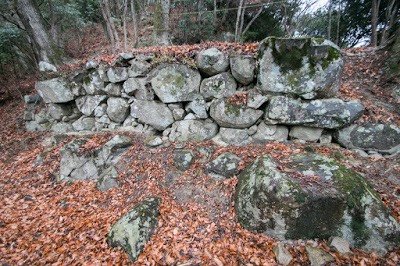Like Musashi, Shiota Hamanosuke Kiyokatsu (1577–1648) e was born in the province of Harima, where he grew up in the village of Shiota, the place from which his family derived its name. Situated some ten miles north of the town of Himeji, the hamlet of Shiota has disappeared from the maps, but its name is still remembered by the famous Shiota onsen, or the Shitoa hot springs, just outside Yumesaki machi.
Hamanosuke’s father had served Akamatsu Norifusa, who had his headquarters at Okishio (also Ojio) castle, which graced the summit of Shiroyama hill, just north of Himeji. In 1580, however, the castle was dismantled as part of Toyotomi Hideyoshi’s strategy to bring Harima under his control. It’s beams and massive stones were used to construct the To no Ichi gate of Himeji castle, at that time Hideyoshi’s headquarters. Five years later, Norifusa was ordered to relocate to Katori castle, in the Province of Awa, in Shikoku.
During the last decade of the sixteenth century, Hamanosuke entered the service of Hosokawa Tadaoki, at that time still the master of Miyazu castle, in province of Tango, on Honshu’s western shore. It was probably whilst in Tadaoki’s service that he became an expert in the art of hoshu jutsu, although it is not known under whom he practiced. In 1600, Hamanosuke followed his lord to Kokura and it was there that he and Musashi met for the first time. It was probably because of their shared background that he and Musashi became friends.
When, in 1632, Tadaoki’s son, Tadatoshi, was promoted to the fiefdom of Kumamoto, Hamanosuke moved to Kumamoto, where he continued to serve both Tadatoshi and his son, Hosokawa Mitsunao (1690–50), as a shihan in the art of hoshu jutsu. He also commanded a large retinue of samurai, earning a stipend of fifteen koku. He is believed to have died in 1648, three years after his friend, at the age of seventy-one.
Though there are accounts of earlier encounter, it was probably during the twilight of their years that both men saw most of each other, as Musashi had by then also moved to Kumamoto on the invitation of Hosokawa Tadatoshi. seems that Hamanosuke had a similar disposition as his famous friend and was known for his quick temper. Thus the Bushū denraiki describes how:
武州、肥後に於て、鹽田濱之允所にて、手錠を見玉ひ、「是にては男子の手には不相應なり。京女抔のやさしき手には相應の器」との玉ふ。濱之允が腹を立、「唯今迄數十人の手にをろし候へ共、少も危き事なし」と答。武州、「さらば、予が手にをろし見よ」との玉ふ。濱之允、即時に武州の腕にはめ、錠をヽろす。其時、武州、左右の手に力を入、「えい」と云て一同に捻玉へば、手錠開き、か子折たり。
One day, while staying at the house of Shiota Hamanosuke in Higo, Musashi was shown a pair of manacles and said: “These are not fit for the wrists of a man. These implements are made for tender wrists such as those of women from Kyoto.” At this Hamanosuke grew angry, saying “thus far I have put them on dozens of men and never once have they let me down.” Musashi replied and said: “If that is so, then try and put them on me.” No sooner had he said this than Hamanosuke had already clamped the manacles around Musashi’s wrists and turned the key. Musashi now tensed his left and right hand and, uttering a cry, twisted the manacles and broke them open. The iron had broken under the strain.
Any queries of remarks? Launch or join a discussion at our new FORUM

